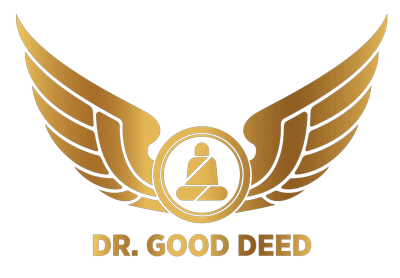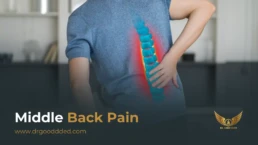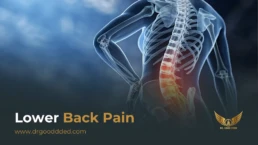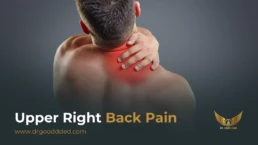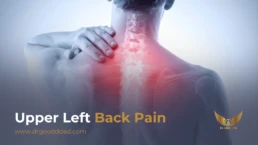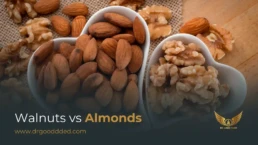Back pain after eating can feel strange and uncomfortable. Some people notice it as a dull ache, while others feel sharp or burning pain that starts right after meals. It can appear in the upper, middle, or lower back, and sometimes it’s linked to stomach or organ issues. In many cases, it’s harmless and related to posture or overeating, but in some cases, it can signal gallbladder, pancreas, or heart problems.
Table of Contents
ToggleWhat Does It Mean When Your Back Hurts After a Meal?
Pain in the back right after eating means your body is reacting to the meal in some way. The pain can come from your digestive system, muscles, or even your heart. The position in which you eat, the size of your meals, and what you eat all play a role. For example, a large, greasy meal can trigger heartburn, which can cause pain to spread into your upper back.
If the pain is mild and occasional, it’s often due to digestion or posture. But if the pain happens often, feels severe, or spreads to your chest, shoulders, or jaw, it might point to a more serious problem.
Main Causes of Back Pain After Eating
Digestive and Gastrointestinal Causes
- Acid Reflux (GERD) and Heartburn
Acid reflux happens when stomach acid flows backward into the food pipe (esophagus). It causes a burning pain in the chest that may spread to the upper back. The pain can start within minutes of eating, especially after spicy, fatty, or acidic meals. - Gallbladder Issues (Gallstones, Inflammation)
The gallbladder stores bile, a fluid that helps digest fat. When gallstones block the bile ducts, it causes sharp pain that often spreads to the right shoulder or back. Many people feel upper back pain after eating fatty foods like fried chicken or cheese-heavy dishes. - Peptic Ulcers or Stomach Ulcers
Ulcers are open sores in the lining of the stomach or upper small intestine. They cause dull or burning pain in the middle of the belly that sometimes spreads to the back. Some people feel relief after eating, while others feel worse. - Pancreatitis (Inflammation of the Pancreas)
Pancreatitis is inflammation of the pancreas, an organ that helps digest food. It causes severe upper belly pain that radiates to the middle of the back. The pain often appears after a heavy or oily meal and may come with nausea or vomiting. - Irritable Bowel Syndrome (IBS) or Indigestion
IBS or indigestion can cause bloating, gas, and pressure in the belly, which may lead to mid-back pain after eating. The discomfort can last for hours and is often worse after large meals.
Musculoskeletal Causes
- Poor Posture During or After Eating: Slouching or leaning forward while eating puts extra stress on back muscles. Over time, this can lead to muscle fatigue and pain. People who sit hunched over screens during meals are especially prone to pain in the back after eating.
- Muscle Strain from Overeating or Sitting Incorrectly: Overeating makes the stomach expand, pushing against nearby muscles and nerves. This can cause tightness and pain, especially in the lower and middle back areas.
Cardiovascular and Systemic Causes
- Heart Attack or Angina (Referred Pain to Back): Not all heart pain feels like chest pain. Some people, especially women, feel pain in their back, jaw, or left arm. Pain that comes after eating, especially with shortness of breath, sweating, or dizziness, may indicate heart strain.
- Aortic Aneurysm (Rare but Serious): This condition causes the main artery to bulge or tear, leading to sudden, severe pain in the chest, belly, or back. It’s rare but life-threatening and requires emergency care.
Other Possible Triggers
- Food Intolerances and Allergic Reactions: Some foods can cause inflammation or allergic reactions that make muscles tighten. Lactose, gluten, or certain processed foods are common triggers.
- Stress and Anxiety-Related Muscle Tension: Emotional stress makes the body tense up. After eating, stress hormones can cause muscle tightening in the neck and back, resulting in high back pain after eating or middle back discomfort.
Location-Based Pain Guide
Upper Back Pain After Eating
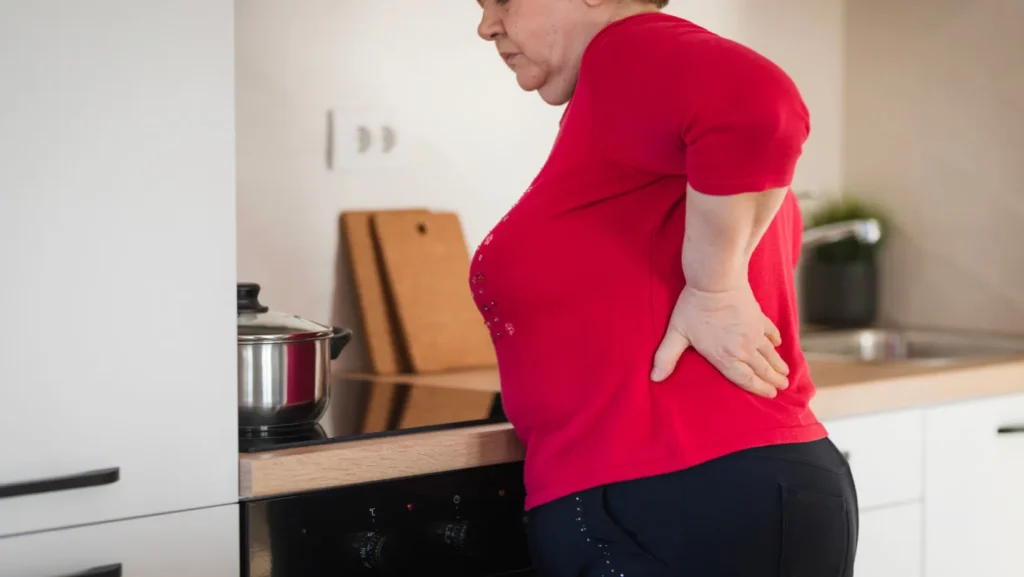
Upper back pain after eating often links to acid reflux, gallbladder problems, or even heart issues. It may feel like a dull ache or burning between the shoulder blades. If the pain comes with nausea or chest discomfort, it’s best to check with a doctor.
Middle Back Pain After Eating
Pain middle of the back after eating or mid-back pain after eating can come from ulcers, pancreatitis, or posture-related strain. The pain often feels deep, aching, and steady, not sharp.
Lower Back Pain After Eating
Lower back pain after meals is often linked to bloating, constipation, or kidney issues. Eating large meals without enough water worsens it.
Symptoms That Accompany Back Pain After Eating
- Digestive Symptoms: Bloating, nausea, burping, or stomach cramps often appear alongside back pain after eating. These signs suggest a digestive source.
- Muscular Symptoms: Tightness, stiffness, or spasms that improve with stretching usually mean the pain is muscle-related.
- Systemic Signs: Chest tightness, heavy sweating, or fatigue may point to heart or pancreas problems and should never be ignored.
When To Seek Medical Attention
Signs of Serious Conditions
Seek immediate help if you notice:
- Sharp, stabbing, or sudden back or chest pain after eating
- Pain spreading to your shoulder, jaw, or arm
- Shortness of breath, dizziness, or heavy sweating
- Nausea or vomiting that won’t stop
- Yellow skin or eyes (jaundice)
- Vomiting blood or black stools
- Fever, chills, or signs of infection
Which Doctor To Consult
For digestive causes, see a gastroenterologist. For muscular issues, an orthopedic specialist or physiotherapist can help. For chest or heart-related pain, visit a cardiologist or emergency room.
Diagnosis And Tests
Your doctor will run a few checks to find the cause of your back pain after eating and rule out serious issues.
Medical History and Physical Examination
Your doctor will ask you questions about your eating habits, the type of pain you feel, and when it appears. They’ll check your belly and back for tenderness, swelling, or tightness. Be honest about your diet, alcohol use, and any stress or anxiety you experience.
Imaging: Ultrasound, CT, or MRI
- Ultrasound: checks gallbladder, liver, and bile ducts
- CT scan: looks for pancreas, stomach, or organ issues
- MRI: detects soft tissue or blood vessel problems
Blood Tests for Gallbladder, Pancreas, and Infections
A simple blood test can reveal signs of inflammation, infection, or organ damage. Your doctor may check liver enzymes, pancreatic enzymes (amylase and lipase), and white blood cell counts. Abnormal results can point to pancreatitis, gallbladder disease, or infection.
Endoscopy for Digestive Tract Issues
An endoscopy involves inserting a thin, flexible tube with a camera into your mouth to look at your esophagus, stomach, and upper intestine. It helps your doctor find ulcers, irritation from acid reflux, or other internal problems that might cause back pain after eating. The procedure is usually safe and done under light sedation, so you won’t feel discomfort.
Treatment Options For Back Pain After Eating
Lifestyle and Home Remedies
- Eat smaller meals more often.
- Sit upright during and after eating for at least one hour.
- Avoid lying down right after meals.
- Use warm compresses on sore muscles.
- Practice light walking after eating to help digestion.
Medical Treatments
Doctors may recommend:
- Antacids or acid reducers for reflux.
- Antibiotics or acid blockers for ulcers.
- Pain control and fluids for pancreatitis.
- Removal of the gallbladder if stones are the cause.
Surgical Options
If gallstones or an aneurysm are behind your pain, surgery might be required. Surgery is only used when medical treatment cannot manage the issue or when the condition is life-threatening.
Prevention Tips And Healthy Habits
Eat Smaller, Balanced Meals
- Avoid heavy meals that put pressure on the stomach.
- Eat 5–6 smaller meals instead of 3 large ones.
- Include lean proteins, veggies, and fiber-rich foods.
- Stay upright for 30–60 minutes after eating.
Maintain a Straight Posture During and After Eating
- Sit upright with shoulders relaxed and back supported.
- Keep your feet flat on the floor while eating.
- Avoid slouching or lying down after meals.
- Good posture prevents mid-back pain after eating.
Avoid High-Fat and Spicy Foods
- Limit fried, oily, and spicy meals.
- Choose grilled or baked dishes instead.
- Spicy or fatty foods can cause upper back pain after eating.
- Identify and avoid foods that trigger your symptoms.
Manage Stress and Anxiety Levels
- Stress can cause pain in the back after eating due to muscle tension.
- Practice deep breathing or meditation after meals.
- Take short walks to relax your body.
- Eat slowly in a calm environment.
Stay Physically Active
- Exercise improves digestion and muscle strength.
- Walk or stretch lightly after eating.
- Do yoga or core exercises to reduce high back pain after eating.
- Stay active daily to prevent stiffness and poor posture.
Possible Long-Term Complications If Ignored
Chronic Digestive Disorders
Ignoring back pain after eating can allow underlying digestive problems, such as acid reflux or gallbladder disease, to worsen. Over time, this may lead to inflammation, ulcers, or chronic indigestion that affects daily life.
Postural and Muscular Imbalances
Constant poor posture and untreated muscular strain can cause long-term back problems. Weak or tight muscles lead to stiffness, limited flexibility, and recurring pain even when not eating.
Worsening of Underlying Cardiac or Gallbladder Disease
Sometimes, back pain after eating signals early heart or gallbladder trouble. Without timely medical care, these conditions can progress into serious complications like heart attacks, gallbladder infections, or even organ damage. Detecting and treating the cause early helps protect both your heart and digestive health.
FAQs
Why does my upper back hurt after eating fatty foods?
Fatty foods force the gallbladder to work harder, causing upper back pain after eating if gallstones or inflammation are present.
Can back pain after eating be a sign of gallbladder problems?
Yes, gallbladder inflammation or stones can trigger pain in the back after eating fatty meals.
What’s the difference between acid reflux pain and back pain?
Acid reflux causes burning that moves upward, while muscle pain feels dull and changes with movement.
Is it normal to feel bloated and have back pain after meals?
Yes, bloating from overeating or gas can cause pain in the middle of the back after eating.
Can overeating cause temporary back pain?
Yes, overeating expands the stomach, pressing on nearby nerves and muscles, leading to discomfort.
What kind of doctor should I see for back pain after eating?
Start with your family doctor. They may refer you to a gastroenterologist, orthopedist, or cardiologist.
Can posture cause back pain while eating or right after?
Yes, slouching strains back muscles, especially after big meals. Sit straight to prevent pain.
Does drinking water help reduce back pain after meals?
Water improves digestion, prevents constipation, and can ease mild mid-back pain after eating.
How do I know if my back pain is coming from my stomach or muscles?
Pain that changes with movement is usually muscular. If pain comes with nausea or vomiting, it’s likely digestive.
When should I go to the ER for back pain after eating?
If pain comes with chest pressure, sweating, or fainting, seek emergency help.

This article is medically reviewed by Dr. Chandril Chugh, Board-Certified Neurologist, providing expert insights and reliable health information.
Dr. Chandril Chugh is a U.S.-trained neurologist with over a decade of experience. Known for his compassionate care, he specializes in treating neurological conditions such as migraines, epilepsy, and Parkinson’s disease. Dr. Chugh is highly regarded for his patient-centered approach and dedication to providing personalized care.
